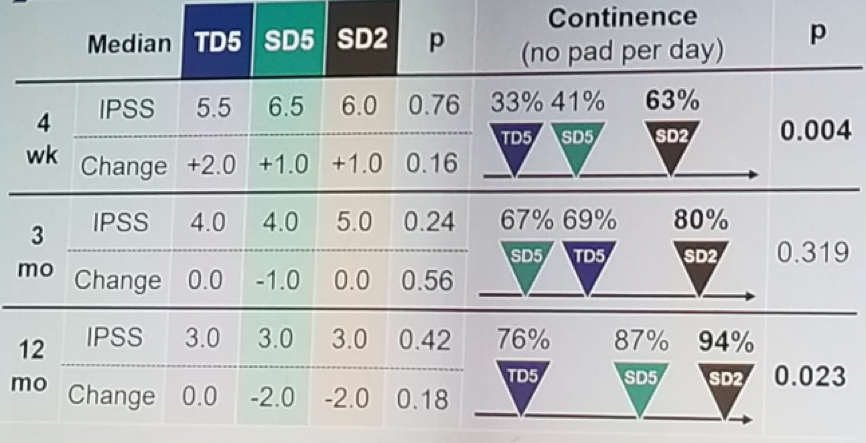According to Dr. Harke, there is still an ongoing debate on the type and duration of the catheter that should be left after RALP. This influences patient comfort and can potentially impact the functional status and continence postoperatively. There have been several studies showing improved patient comfort after placement of a suprapubic catheter rather than a urethral catheter. However, no prospective study has yet to analyze the catheter’s effect on functional results.
This was a prospective randomized study with three arms, randomizing patients 1:1:1 to each arm.
Overall 198 patients were included in the study, and all underwent RALP. Postoperatively, patients were randomized to a transurethral catheter that was removed on day 5 (TD5), or a suprapubic catheter that was removed on day 5 (SD5) or removed on day 2 (SD2). All patients were followed for 12 months. ALL 3 arms were well balanced as can be seen in table 1.

Table 1 – Patient clinical characteristics in all three arms:
After the catheter was removed, no difference was seen between the three arms with regards to the rate of complications, catheter-related problems, and residual bladder volume. However, a significant difference was noted in the 12-hour pad test, with TD5, SD5, and SD2 demonstrating 30, 24, and 14 cc, respectively, p=0.007. This difference, showing superior continence in the early removal arm, was consistent at four weeks, three months and 12 months postoperatively (Table 2).

Table 2 – Continence rate in the three arms over time:
Dr. Harke concluded her presentation of this interesting study by stating that this study demonstrated similar postoperative patient comfort, complication rate and voiding quality among the different catheter arms. However, continence rates were significantly better at short-term and long-term follow-up for patients whose suprapubic catheter was removed earlier.
Presented by: Nina Harke, Essen, Germany
Written by: Hanan Goldberg, MD, Urologic Oncology Fellow (SUO), University of Toronto, Princess Margaret Cancer Centre, Twitter:@GoldbergHanan at the EAU Robotic Urology Section (ERUS) Meeting - September 5 - 7, 2018 - Marseille, France